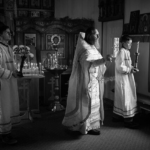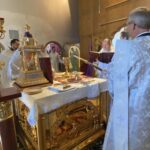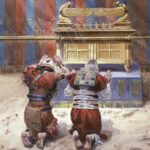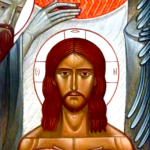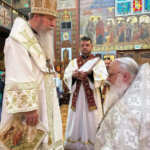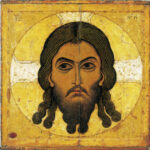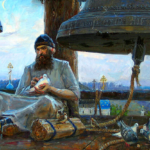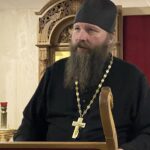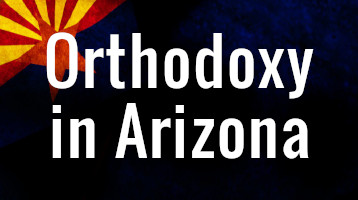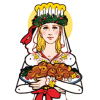The Russian Orthodox Church Outside of Russia now has a second canonical Old Rite parish in America. In 1983, the Church of the Nativity of Christ in Erie, Pennsylvania, joined ROCOR and the parish leader was ordained as its first priest—Fr. Pimen. There are many parallels between the Erie parish and the Old Believer community in Nikolaevsk, Alaska, which is now on the same path, reports Sokritaya Rus’. The village of Nikolaevsk was founded in 1968. Today there are about 350 inhabitants. The community was originally of the priestless Old Believer tradition, but in 1983, a bishop in Romania ordained Nikolai Yakunin to the priesthood, who is now leading the community—with his son, Deacon … [Read more...]
Axios! New Ordinations for ASONA
Axios and congratulations to our newly ordained clergy. Priest Joseph MacPherson, and Deacon Patrick Gill were ordained at Holy Transfiguration Cathedreal in Los Angeles on their patronal feast day Monday August 19th, 2024 by Archbishop Kyrill of San Francisco and All Western America. Several parishioners had driven all the way to LA and were on hand for the liturgy. See the gallery below. Axios! … [Read more...]
ASONA Feast Day: Hierarchical Divine Liturgy
On Sunday, July 14, 2024, ASONA celebrated our Patronal Feast, and the hierarchical visitation of Bishop James of Sonora. It was the first time one of our bishops attended the new location for ASONA. A feast followed the Hierarchical Divine Liturgy. Here is a photo gallery of the event. … [Read more...]
Is There Such a Thing as Moral Heresy?
Apologetic students take notes! by Fr. John Whiteford We have previously discussed Aristotle Papanikolaou's strange notion that, unlike the dogmas of the Church, Orthodox Christian morality is open to dispute and change (see The Living Church 2.0). In the wake of a recent conference in Oxford of Orthodox "scholars, pastors, clinicians, and other experts" who gathered to "dialogue" about LGBTQP+ issues, Papanikolaou has asserted that never in the history of the Church has the term "heresy" been used to describe a false teaching on a moral issue. In the course of a Twitter exchange about the problems with this conference, I commented: "It's the idea that holding the position that … [Read more...]
Is the Veneration of the Cross Idolatry?
by Fr. John Whiteford If we look at the Scriptures and to Jewish custom, the answer is clearly “No.” Another grand slam from the Bible – from Fr. John’s “Stump the Priest” column Question: How would you answer a Protestant who considered our veneration of the Cross (bowing down before it and kissing it) to be idolatry? First we should consider whether or not bowing down before something or kissing it entails the worship of adoration that is due to God alone. If we look at the Scriptures and to Jewish custom, the answer is clearly “No.” Abraham bowed himself before the people of Hebron (Genesis 23:7, 12); Joseph’s brothers bowed before him (Genesis 42:6; 43:26, 28); and many other … [Read more...]
Why Did Christ Need Baptism?
A question asked by many is, “Why did Jesus need to be baptized?” To answer this, let’s first explore the nature of baptism as explained by Saint John Chrysostom. Jewish Baptism Saint John Chrysostom points out that the Jewish Baptism was one of cleansing. He says, There was a Jewish baptism, which cleansed from bodily impurities, but not to remove sins. Thus, whoever committed adultery, or decided on thievery, or who did some other kind of misdeed, it did not free him from guilt. But whoever touched the bones of the dead, whoever tasted food forbidden by the law, whoever approached from contamination, whoever consorted with lepers — that one washed, and until evening was impure, … [Read more...]
ASONA Rector Elevated to Archpriest
Christ is Risen! Truly, He is Risen! On Sunday, May 12, 2024 at the new Holy Virgin Cathedral in San Francisco, his eminence Archbishop Kyrill, Archbishop of San Francisco and Western America elevated the rector of ASONA, Priest John A. Peck to the rank of Archpriest. Archpriest, (Greek: πρωτοπαπᾶς, protopapas) or protopresbyter (Greek: πρωτοπρεσβύτερος, protopresbyteros), is a clerical rank, a title of honor given to non-monastic priests and is conferred by a bishop with the laying on of hands and prayer. The ceremony for making an archpriest is analogous to other clerical promotions bestowed with cheirothesia: at the Little Entrance of the Divine Liturgy, the candidate is conducted … [Read more...]
On the Essence of Icons, by St. Photios
by St. Photios the Great St. Photius, Patriarch of Constantinople, preached a sermon on the day the icon of the Theotokos was dedicated in Hagia Sophia, 29 March 867. In the notes introducing the English translation of the sermon, we find this comment: “In the eyes of Photius, painting is the most direct form of instruction, for a picture that is in agreement with religious truth contains the eidos, or essence, of the prototype, which is in turn apprehended by the faculty of sight and indelibly imprinted upon the mind. A painter is guided by divine inspiration, so that his work is not merely mimetic, but contains an actual share of the prototype. One would look in vain for a better … [Read more...]
Who Invented Church Bells, and What Are the Rules for Ringing Them?
On February 5, the Church celebrates the memory of St. Paulinus the Merciful. The appearance of church bells and bell ringing in Europe is associated with his name. In Russia, where bells came along with Christianity, the art of bell ringing acquired its own specific characteristics over time. Saint Paulinus the Gracious lived in the 5th century. He received a good education, at the age of 20 he became a senator, and a little later the proconsul of the Campania region in Italy. Subsequently, for the sake of serving God and his neighbors, the saint decided to abandon his public career: he accepted holy orders, and then was elevated to the rank of bishop and became the bishop of the city of … [Read more...]
Inaugural Arizona Liturgical Practicum Accomplished
On Monday, January 29, Hiermonk Peter (Karakazoff) inaugurated the Arizona Liturgical Practicum at All Saints of North America Orthodox Church, in Sun City, Arizona. Sponsored by the GreatMartyr Euphemia Orthodox Theological Academy, this weeklong event ended Thursday night, February 1st. The practicum was attended by local clergy and laity alike, and provided a unique opportunity for a deep dive into Orthodox liturgics. Hieromonk Peter is the priest at the Old Holy Virgin Cathedral in San Francisco, CA, and was the Archdeacon of the Western American Diocese for many years. He is a walking encyclopedia of liturgical history, symbolism, knowledge, development, and practice. His … [Read more...]
- « Previous Page
- 1
- …
- 3
- 4
- 5
- 6
- 7
- …
- 29
- Next Page »
